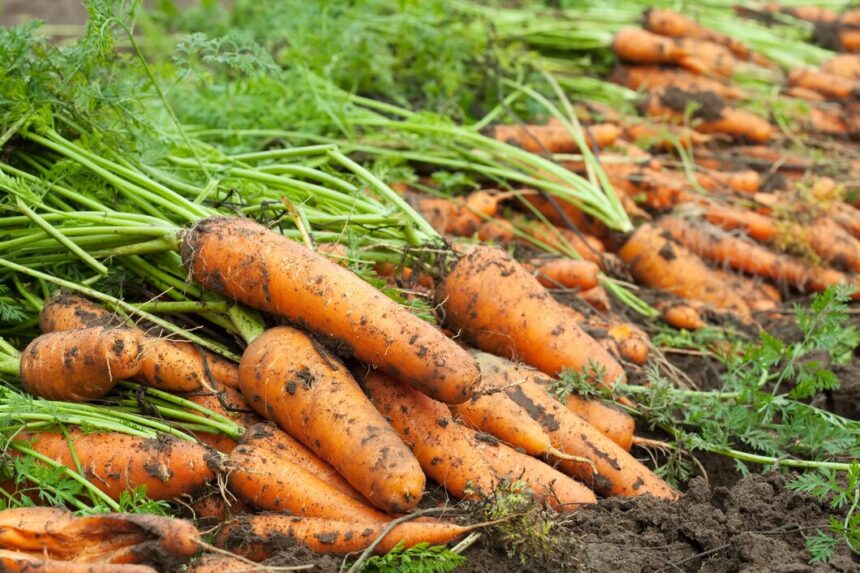Carrots (Daucus carota) are a popular root vegetable known for their versatility, flavor, and nutritional benefits. Growing carrots successfully requires careful planning and management throughout their growth stages. This article provides detailed information on growing carrots from seed to harvest, covering land preparation, growth stages, inputs, machinery, pests, diseases, and storage.
1. Land Preparation
Soil Type
Carrots thrive in well-drained, sandy loam or loamy soils with a pH range of 6.0 to 6.8. Avoid heavy clay soils, which can hinder root development.
Land Preparation Steps
- Clearing: Remove any debris, weeds, or previous crop residues from the field.
- Tilling: Plow the soil to a depth of 20-30 cm to break up compaction and improve aeration.
- Soil Amendment: Incorporate organic matter (compost or well-rotted manure) to enhance soil fertility and structure. Consider soil testing to determine nutrient needs.
- Raking: Level the soil surface to ensure uniform seed distribution.
2. Seed Selection and Sowing
Seed Selection
Choose high-quality carrot seeds suited for your climate. Popular varieties in South Africa include ‘Nantes’, ‘Imperator’, and ‘Danvers’.
Sowing Method
- Timing: Sow seeds in late summer to early spring, avoiding extreme heat and frost.
- Row Spacing: Plant seeds in rows 30-45 cm apart, with seeds spaced 2-4 cm within rows.
- Depth: Sow seeds at a depth of 1-2 cm. Cover lightly with soil and firm down gently.
3. Germination and Seedling Stage (1-3 Weeks)
Germination
Carrot seeds germinate within 10-20 days, depending on soil temperature and moisture. Optimal soil temperature for germination is between 15-20°C.
Watering
Maintain consistent moisture in the soil during this stage, watering lightly every 2-3 days to prevent crusting that can hinder seedling emergence.
4. Vegetative Growth Stage (4-8 Weeks)
Thinning
Once seedlings have developed true leaves, thin them to 5-10 cm apart to reduce competition for nutrients and water.
Watering
Increase watering frequency to maintain soil moisture. Carrots require about 25-30 mm of water per week during this stage.
Fertilization
Apply a balanced fertilizer (e.g., 10-10-10 NPK) at planting and again 4-6 weeks later, following soil test recommendations. Avoid high nitrogen fertilizers to prevent excessive leafy growth at the expense of root development.
5. Root Development Stage (9-12 Weeks)
Soil Management
Continue to monitor soil moisture, ensuring it does not dry out. Carrots need consistent moisture for optimal root development.
Weed Control
Implement weed management strategies, such as hand weeding or using shallow cultivation. Avoid using herbicides that may damage carrots, especially during early growth.
Pest and Disease Monitoring
- Pests: Watch for aphids, carrot flies, and root maggots. Use insect traps or natural predators as needed.
- Diseases: Common diseases include downy mildew and leaf blight. Maintain good airflow around plants and remove any infected foliage.
6. Maturation and Harvesting (12-16 Weeks)
Harvest Timing
Carrots are typically ready for harvest 12-16 weeks after sowing, depending on the variety. Harvest when roots reach 2-5 cm in diameter.
Harvesting Method
- Use a fork or spade to loosen the soil around the roots before pulling them gently to avoid damage.
- For larger plantings, consider using a tractor-mounted harvester for efficiency.
7. Post-Harvest Handling
Cleaning
Remove excess soil from the roots by gently brushing them. Avoid washing them, as excess moisture can lead to rot.
Storage Conditions
- Store carrots in a cool, dark, and humid environment (0-4°C with 90-95% humidity).
- Use perforated plastic bags or crates to allow air circulation.
8. Disease and Pest Management
Pesticides and Herbicides
- Insect Pests: Use insecticidal soap or neem oil to manage pests like aphids. Apply when pest populations are low to minimize harm to beneficial insects.
- Diseases: Fungicides may be necessary for controlling fungal diseases. Apply according to label instructions at the first signs of infection.
- Weeds: In cases of severe weed pressure, a selective herbicide may be applied post-emergence, but always follow label guidelines to avoid harming carrot plants.
Growing carrots from seed to harvest requires careful attention to detail throughout the entire process. By understanding the needs of this crop and implementing best practices in land preparation, watering, fertilization, pest management, and harvesting, South African farmers can achieve a successful carrot crop. With the right management strategies in place, carrots can be a profitable and rewarding addition to any farm.
Join 'Farmers Mag' WhatsApp Channel
Get the latest Farming news and tips delivered straight to your WhatsApp
CLICK HERE TO JOIN






